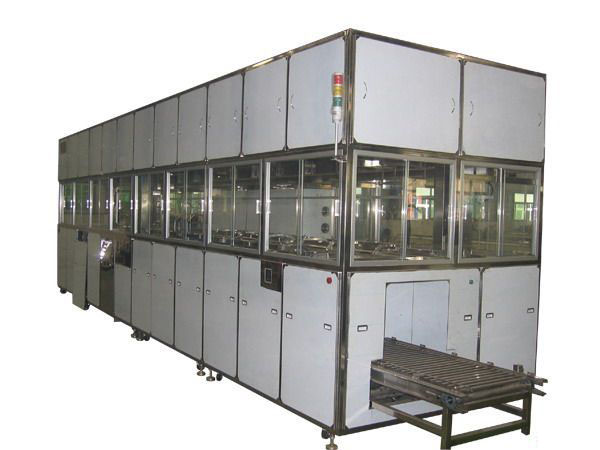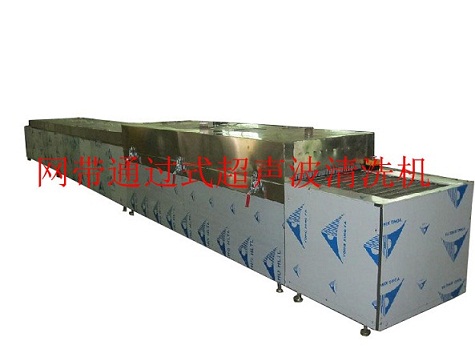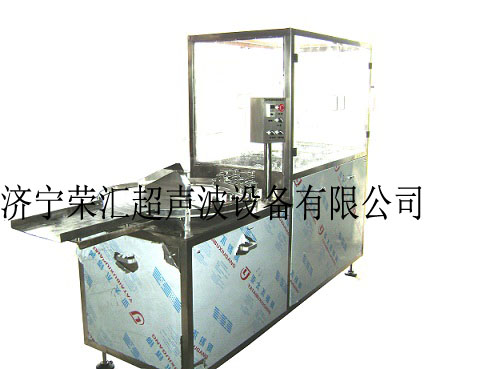The basic mechanism of ultrasonic cleaning principle In the current tide of market economy, the scope of application of ultrasonic cleaning machines more widely, in the normal work and life of people is playing an increasingly important role! Various production companies on the quality of their products have become increasingly stringent product quality requirements higher and higher, all manufacturers to guarantee the quality of their own products, ultrasonic cleaning machines now more and more attention has been paid, Many problems that cannot be cleaned by hand can be solved by handing the problem to the ultrasonic cleaner. The cleaning of a workpiece can be divided into two methods, physical and chemical. For example, it can be cleaned by physical force. For example, the laundry is used to wash the dirt of the clothes back and forth, such as washing the surface of the workpiece with a high-pressure water gun. These are physical. Force cleaning. There are also chemical cleaning methods, such as washing powder and clothing dirt, the corresponding chemical reaction. Acid treatment is also used when cleaning rust. These are all methods of chemical cleaning. If the ultrasonic cleaning with tap water or clean water is a physical cleaning, if some detergent is added to the cleaning liquid, it is a combination cleaning. Different detergents are used for different cleaning objects, and the cleaning effect is obvious. .  cleaning method Residual residue % Compressed air blow cleaning 86 Immersion cleaning 70 Steam cleaning 65 Brush cleaning 8 Ultrasonic cleaning 0-0.5 Table 1 compares the cleaning effects of several cleaning methods.  The above data are from the authoritative department report!  One of the principle decryption: the cleaning solvent is placed in the ultrasonic cleaning tank to apply ultrasonic waves to the tank. Since the ultrasonic wave is a dense vibration wave like the sound wave, the pressure of the medium alternates. If you observe a certain point in the liquid, the pressure at this point is  The curve A below is shown. Static pressure (typically atmospheric pressure) as the center, increase or decrease the pressure generated, when the ultrasonic waves are sequentially enhance the strength, the pressure also increases as the amplitude, like curve B shown in FIG. 2. The oscillating signal of the frequency higher than 20KHz is amplified by the ultrasonic generator and converted into high-frequency mechanical vibration energy by the inverse piezoelectric effect of the ultrasonic transducer (shock), and the cleaning liquid is cleaned by the acoustic radiation in the cleaning medium. Molecular vibrations produce numerous tiny bubbles. The bubble forms and grows in the negative pressure zone along the direction of ultrasonic propagation, and is rapidly closed in the positive pressure zone to generate thousands of atmospheric pressures, and forms numerous microscopic high-pressure shock waves acting on the surface of the workpiece to be cleaned. This is the "cavitation effect" in ultrasonic cleaning. Ultrasonic cleaning machines work on the basic principle of “cavitation effectâ€.  Decryption Principle II: soil peeling reason: when a strong shock wave is generated by ultrasonic cavitation bubbles burst, the dirt layer is peeled shockwave, i.e. dispersion and off.   Due to bubbles generated by cavitation as shown in a FIG. The gap between the dirt layer formed by the impact and the surface penetrates into the gap, and the small bubble expands and contracts in synchronism with the sound pressure, and the physical force like peeling is repeated.  A fouling layer, a dirt layer is stripped, as shown at b in FIG. The small bubbles continue to move forward until the dirt layer is peeled off. This is the secondary effect of cavitation.  For example: 20kHz, when 2 w / cm 2 of the ultrasonic wave propagating in the washing liquid, the particle will cause vibration, speed 0 16m / s, acceleration 2. 04X10 4 m / sz , sound pressure is 1 . 45X10 5 Pa, suggesting that would have been 20,000 times per second layer of intense shock dirt cleaned surface. This high-intensity, high-frequency impact, even with a strong dirt layer, is difficult to escape the violent "attack" of ultrasonic mechanical waves.  Principle Decryption 4: The cleaning agent also dissolves the dirt and produces a chemical force for emulsification and dispersion. The cleaning agent can chemically react with the dirt on the workpiece to be cleaned, and the dirt is quickly disintegrated under the violent attack of the ultrasonic waves. The main principle of ultrasonic cleaning is ultrasonic cavitation. To obtain good cleaning effect, it is very important to choose the acoustic parameters of the sound field in the cleaning tank and the physical and chemical properties of the cleaning fluid.  How does ultrasonic cavitation occur? 5 Cavitation is related to the viscosity of the medium, the viscosity is large, the surface tension is large, and the cavitation is high.  Ultrasonic cleaning application  : Wash tank: a wash tank for holding the washing liquid and the workpiece is cleaned stainless steel container, most of the first workpiece can be mounted in the frame mesh, and then put together into the cylinder cleaning.  Ultrasonic generator: Ultrasonic generator for ultrasonic cleaning machine, the types of components used can be divided into tube type, thyristor type and transistor type. In recent years it has developed into a high-power "power module" party  formula. Output power from several tens of watts up to several kilowatts, the operating frequency shown in FIG. 25K Hz- 120K Hz is as follows: Ronghui ultrasonic generator features:  Ultrasonic transducers: The transducers used in ultrasonic cleaners are mainly the following:  Such transducers typically consist of two piezoelectric ceramic wafers. A cleaning machine uses a plurality of transducers, which are bonded to the bottom of the cleaning cylinder via an adhesive and connected in parallel to form a transducer of a cleaning machine. The distance between the transducer elements (for a frequency of 20 K H z is generally 5-10 c m , too large, it is easy to produce bending vibration, and the vibration plate is corroded, while the radiation surface is relatively reduced ) .  Jining Ronghui Ultrasonic Equipment Co., Ltd. is a professional company specializing in the production of ultrasonic cleaning equipment. It has considerable experience in the industry and has achieved a lot of achievements. If you want to know about ultrasonic cleaning, please consult and understand us. Will help you! Frozen Pud Red Shrimp,Red Shrimp,Frozen Shrimp,Melantho Shrimp Zhoushan Haiwang Seafood Co., Ltd. , https://www.haiwangseafoods.com
Handy ultrasonic cleaning machine: for example, for cleaning the watch parts, optical glasses, microscope lenses, engine parts, crankshaft, cylinder block, cylinder head, a crankshaft, connecting rod, gear box, clutch, precision bearing parts, gears, Piston rings, knives , saw blades, jewellery , medical syringes , medical bottles, aluminum covers, aluminum plastic covers, laboratory glassware, etc.; can also be used to clean PCBA boards , SMT patches, semiconductor wafers , picture tubes Precision parts, ceramic components, silicon wafers, ceramic wafers, welding wire , and other products. Â
Classification of ultrasonic cleaning methods:
Introduction to the principle of ultrasonic cleaning : 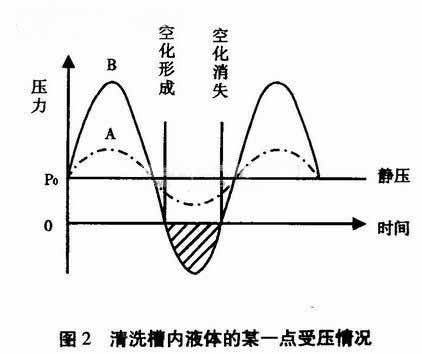


Principle Decryption 3: The ultrasonic vibration of the cleaning fluid in the ultrasonic cleaning itself is a force for cleaning.
Since cavitation is the most important role of ultrasonic cleaning , how do you create cavitation ? In general, cavitation is determined not only by the properties of the medium, but also by the sound field. The level of cavitation nuclei is subject to many factors, mainly due to the following factors: Â
1 Cavitation is related to the operating frequency f . The higher the frequency, the higher the cavitation threshold value and the more difficult it is to create cavitation. The bubble will vibrate under the action of the sound field, but it does not necessarily collapse (broken), only when the frequency of the sound wave is lower than the bubble  When the resonant frequency is high, the bubble may be broken. When the frequency of the sound wave is higher than the resonant frequency of the bubble, the bubble only performs complex vibration, and generally no bubble burst occurs. Â
2 The cavitation enthalpy is related to the bubble radius in the medium. The smaller the radius, the higher the cavitation enthalpy. Â
3 Baohuayu is related to the length of sound wave action. The longer the sound wave radiation time, the lower the cavitation. Â
4 Cavitation is related to ambient static pressure. The higher the static pressure, the higher the cavitation. Â
6 Cavitation is related to the gas content of the liquid. The less the gas content, the higher the cavitation. Â
7 The cavitation enthalpy is related to the temperature of the cleaning fluid, and the temperature of the cleaning fluid rises, which is favorable for cavitation. However, when the temperature of the cleaning liquid is too high, the vapor pressure in the bubble increases, and the cavitation is weakened by the buffering action being enhanced during the bubble closing period. The temperature is also related to the solubility of the cleaning solution. A suitable temperature for the water cleaning solution is about 60 °C . Â
Optimization principle for ultrasonic sound intensity selection:
root  According to the mechanism of ultrasonic cleaning, we can choose the best condition and get the best cleaning effect. It should also be noted that the best sound intensity is chosen. If the sound intensity is too high, a large amount of air bubbles will be generated, and a barrier will be formed on the surface of the sound wave, so that the sound wave is not easily radiated.  It hits the entire liquid space, so the cleaning effect is weakened away from the sound source. At the same time, the sound intensity is too high, and the bubble expands too much, so that the bubble is too late to close in the sonic compression phase. The sound intensity is generally selected at 1 w/ cm 2 -----2 w/ cm 2 , and for some dirt whose metal surface oxide film is difficult to clean, a higher sound intensity should be used.
Ultrasonic cleaning equipment can be divided into general and special purpose ships two models. Â
1 , Â Standard ultrasonic cleaner Â
Ultrasonic cleaning machine structure an ultrasonic wave generator and general cleaning pools separate layout into one or two forms, in general low power (200W or less) integral with the washing machine structure, while the power split structure precedence washing machine. Ultrasonic cleaning machine split structure composed of three main parts, as shown below. Â 
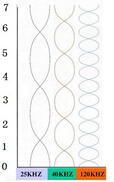
( 1 ) The transducer resonance frequency and impedance vary greatly with the depth of the cleaning fluid. However, practice has shown that after a proper amount of cleaning material is placed in the tank, it can basically be stabilized at a certain value. Â
( 2 ) In general, since the cleaning load variation is small, the complex frequency automatic tracking circuit can be eliminated. Â
( 3 ) Practical ultrasonic generators, most of which use high-power self-excited feedback oscillators.
1 magnetostrictive transducer  Most of the magnetostrictive transducers used in China are window-type transducers that are stacked with nickel sheets, which are silver-welded to the bottom of the cleaning cylinder and then wound around a certain number of turns on the window. The transducer can withstand high power, has good reliability and long service life. The disadvantage is that the efficiency is lower than that of the piezoelectric transducer, and the raw material nickel sheet is expensive. Â
2 piezoelectric transducer  Most current domestic ultrasonic cleaning machine is a piezoelectric transducer, such as the configuration in FIG.  
General ultrasonic cleaning machine cleaning parts have strong applicability and have been widely used in many industries such as electronics, watches, optics, machinery, automobiles, aviation, atomic energy industry, medical equipment and so on. Â
2 special ultrasonic cleaning machine Â
It is usually installed on the production line for cleaning certain specific items. Â For example, RHXP type ultrasonic bottle washing machine, RHXP-K oral liquid bottle washing machine, automatic ultrasonic cleaning machine, semi-automatic ultrasonic cleaning line and other special equipment are as follows: 